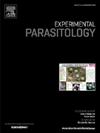加强褐狗虱(Rhipicephalus sanguineus)的饲养:以小鼠(Mus musculus)为血源的活体蜱饲养。
IF 1.6
4区 医学
Q3 PARASITOLOGY
引用次数: 0
摘要
蜱是大量重要病原体的载体,但由于实验室定植的挑战,研究仍不足。本研究介绍了以ICR小鼠(小家鼠)为血源的血蜱在体内饲养的创新技术。这项由沃尔特里德陆军研究所-武装部队医学科学研究所(wrirr - afrims)进行的研究概述了成功利用老鼠来支持蜱虫发育的各个阶段。采用醋酸乙烯酯(EVA)泡沫胶囊将蜱虫留在小鼠体内,并用环磷酰胺预防宿主免疫反应干扰蜱虫摄食。这些方法使血蜱种群得以成功建立和大规模生产。本文所描述的方法有望为机构寻求有效的蜱生产使用啮齿动物模型。本文章由计算机程序翻译,如有差异,请以英文原文为准。

Enhancing brown dog tick rearing (Rhipicephalus sanguineus): In vivo feeding using mice (Mus musculus) as blood sources
Ticks vector a large number of significant pathogens, yet remain understudied due to the challenges in laboratory colonization. This study introduces innovative techniques for rearing Rhipicephalus sanguineus, focusing on in vivo tick feeding using ICR mice (Mus musculus) as a blood source. The research, conducted at the Walter Reed Army Institute of Research - Armed Forces Research Institute of Medical Sciences (WRAIR-AFRIMS), outlines the successful utilization of mice to support all stages of tick development. Ticks were retained on mice using Ethylene-Vinyl Acetate (EVA) foam capsules and cyclophosphamide was administered to the mice to prevent host immune response from interfering with tick feeding. These methods allowed the successful establishment and mass production of R. sanguineus tick colonies. The methods described herein hold promise for institutions seeking efficient tick production using a rodent model.
求助全文
通过发布文献求助,成功后即可免费获取论文全文。
去求助
来源期刊

Experimental parasitology
医学-寄生虫学
CiteScore
3.10
自引率
4.80%
发文量
160
审稿时长
3 months
期刊介绍:
Experimental Parasitology emphasizes modern approaches to parasitology, including molecular biology and immunology. The journal features original research papers on the physiological, metabolic, immunologic, biochemical, nutritional, and chemotherapeutic aspects of parasites and host-parasite relationships.
 求助内容:
求助内容: 应助结果提醒方式:
应助结果提醒方式:


